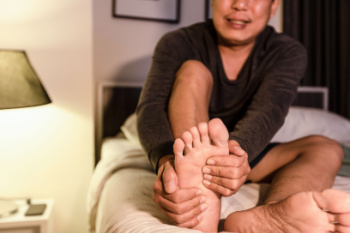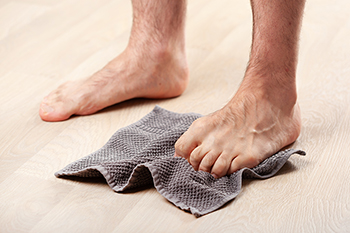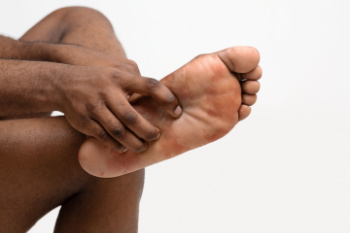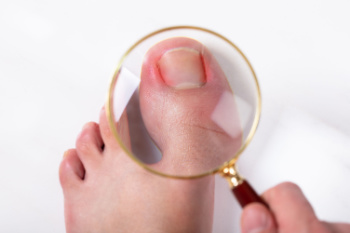Connect With Us
Blog
Items filtered by date: July 2025
Tuesday, 29 July 2025 00:00
Common Foot and Ankle Injuries in Golf

Golf may seem gentle on the body, but it places specific demands on the feet and ankles. Repetitive motions, long hours of walking, and uneven terrain can lead to injuries over time. One of the most frequent issues golfers face is plantar fasciitis, causing heel pain that worsens during or after a round. Ankle sprains are another common problem, often resulting from unstable footing on hills or wet grass. Stress placed on the back foot during the swing can strain tendons and ligaments, particularly the Achilles tendon. Some golfers also develop tendonitis or joint pain from the twisting action required in the golf swing. If pain in your feet or ankles is limiting your time on the course, it is suggested you visit a podiatrist to diagnose the issue and explore treatments that can help you stay active and comfortable.
Ankle and foot injuries are common among athletes and in many sports. They can be caused by several problems and may be potentially serious. If you are feeling pain or think you were injured in a sporting event or when exercising, consult with one of our podiatrists from Advanced Foot Specialists. Our doctors will assess your condition and provide you with quality foot and ankle treatment.
Common Injuries
The most common injuries that occur in sporting activities include:
- Achilles Tendonitis
- Achilles Tendon Rupture
- Ankle Sprains
- Broken Foot
- Plantar Fasciitis
- Stress Fractures
- Turf Toe
Symptoms
Symptoms vary depending upon the injury and in some cases, there may be no symptoms at all. However, in most cases, some form of symptom is experienced. Pain, aching, burning, bruising, tenderness, tightness or stiffness, sensation loss, difficulty moving, and swelling are the most common symptoms.
Treatment
Just as symptoms vary depending upon the injury, so do treatment options. A common treatment method is known as the RICE method. This method involves rest, applying ice, compression and elevating the afflicted foot or ankle. If the injury appears to be more serious, surgery might be required, such as arthroscopic or reconstructive surgery. Lastly, rehabilitation or therapy might be needed to gain full functionality in the afflicted area. Any discomfort experienced by an athlete must be evaluated by a licensed, reputable medical professional.
If you have any questions, please feel free to contact our offices located in Rockwall, Greenville, Dallas, Sachse, and Lewisville, TX . We offer the newest diagnostic and treatment technologies for all your foot care needs.
Tuesday, 22 July 2025 00:00
Peripheral Neuropathy and Its Impact on Foot Health

Peripheral neuropathy, which results from damage to the peripheral nerves, often affects the feet. It can be caused by diabetes, infections, injuries, vitamin deficiencies, or exposure to toxins. This condition disrupts nerve signals, leading to symptoms such as numbness, tingling, burning, weakness, or sharp pain in the feet. Risk factors include chronic illness, alcoholism, certain medications, and genetic predisposition. Peripheral neuropathy can lead to balance issues, ulcers, or unnoticed injuries due to reduced sensation. A podiatrist can help by evaluating nerve function, treating foot complications, and recommending protective strategies. If you are experiencing changes in foot sensation or unexplained pain, it is suggested that you consult a podiatrist to manage symptoms and offer relief solutions for this condition.
Neuropathy
Neuropathy can be a potentially serious condition, especially if it is left undiagnosed. If you have any concerns that you may be experiencing nerve loss in your feet, consult with one of our podiatrists from Advanced Foot Specialists. Our doctors will assess your condition and provide you with quality foot and ankle treatment for neuropathy.
What Is Neuropathy?
Neuropathy is a condition that leads to damage to the nerves in the body. Peripheral neuropathy, or neuropathy that affects your peripheral nervous system, usually occurs in the feet. Neuropathy can be triggered by a number of different causes. Such causes include diabetes, infections, cancers, disorders, and toxic substances.
Symptoms of Neuropathy Include:
- Numbness
- Sensation loss
- Prickling and tingling sensations
- Throbbing, freezing, burning pains
- Muscle weakness
Those with diabetes are at serious risk due to being unable to feel an ulcer on their feet. Diabetics usually also suffer from poor blood circulation. This can lead to the wound not healing, infections occurring, and the limb may have to be amputated.
Treatment
To treat neuropathy in the foot, podiatrists will first diagnose the cause of the neuropathy. Figuring out the underlying cause of the neuropathy will allow the podiatrist to prescribe the best treatment, whether it be caused by diabetes, toxic substance exposure, infection, etc. If the nerve has not died, then it’s possible that sensation may be able to return to the foot.
Pain medication may be issued for pain. Electrical nerve stimulation can be used to stimulate nerves. If the neuropathy is caused from pressure on the nerves, then surgery may be necessary.
If you have any questions, please feel free to contact our offices located in Rockwall, Greenville, Dallas, Sachse, and Lewisville, TX . We offer the newest diagnostic and treatment technologies for all your foot care needs.
Tuesday, 15 July 2025 00:00
Exercises Can Reduce Risk of Running Injuries

Runners often put significant stress on the feet, and poor mechanics or muscle imbalances can increase the risk of overuse injuries. Strengthening and stretching exercises can help reduce strain on foot structures, like the plantar fascia, Achilles tendon, and intrinsic foot muscles. Routines that focus on calf flexibility, toe control, and arch stability can enhance shock absorption and improve foot alignment during running. Having tight calves or weak foot muscles may contribute to problems like plantar fasciitis or Achilles tendinitis. Similarly, imbalances in the lower leg may affect ankle stability and increase the risk of sprains. Exercises like calf raises, towel scrunches with the toes, and controlled ankle movements can strengthen foot and ankle structures. A podiatrist can evaluate your gait, identify structural risks, and recommend exercises or orthotic devices as part of a comprehensive treatment plan. If you are a runner and experience foot pain, it is suggested that you schedule an appointment with a podiatrist for a diagnosis, treatment and effective running injury prevention tips.
Exercising your feet regularly with the proper foot wear is a great way to prevent injuries. If you have any concerns about your feet, contact one of our podiatrists of Advanced Foot Specialists. Our doctors will treat your foot and ankle needs.
How to Prevent Running Injuries
Many common running injuries are caused by overuse and overtraining. When the back of the kneecap starts wearing out and starts causing pain in your knee, this is commonly referred to as runner’s knee. Runner’s knee is a decrease in strength in your quadriceps and can occur if you’re not wearing properly fitted or supporting shoes. To prevent runner’s knee, focusing on hip strengthening is a good idea, as well as strengthening your quads to keep the kneecaps aligned.
What Are Some Causes of Running Injuries?
- One cause of a common running injury is called iliotibial band syndrome.
- Plantar fasciitis is also another common injury.
- Stress fractures can occur from overtraining, lack of calcium, or even your running style.
Best Ways to Prevent Running Injuries
- Wear footwear that fits properly and suits your running needs.
- Running shoes are the only protective gear that runners have to safeguard them from injury.
- Make a training schedule. Adding strengthening exercises as well as regular stretching can help keep you strong and limber and can lessen the possibility of injuries.
- Stretching keeps muscles limber; this will help you gain better flexibility.
If you have any questions please feel free to contact our offices located in Rockwall, Greenville, Dallas, Sachse, and Lewisville, TX . We offer the newest diagnostic and treatment technologies for all your foot and ankle needs.
Tuesday, 08 July 2025 00:00
Ruptures of the Plantar Fascia

A rupture of the plantar fascia can cause sudden, sharp pain in the sole of the foot, often described as a tearing or popping sensation. The plantar fascia is a thick band of tissue that supports the arch and helps absorb the impact of walking and running. While plantar fasciitis is more common, a complete tear is rare. It typically occurs during high-impact sports or sudden movements, especially in people with tight arches or who have a history of foot strain. A plantar fascia rupture may lead to swelling, bruising, and difficulty bearing weight. Diagnosis is usually confirmed through an MRI scan, which helps determine the extent of the damage. In some cases, surgery may be needed, especially if the tissue fails to heal after conservative treatment. A podiatrist can diagnose the problem and guide recovery through wearing supportive footwear, immobilization, or surgery, if needed. If you have extreme pain on the sole of your feet, it is suggested that you promptly schedule an appointment with a podiatrist for an exam and appropriate treatment options.
Plantar fasciitis can be very painful and inconvenient. If you are experiencing heel pain or symptoms of plantar fasciitis, contact one of our podiatrists from Advanced Foot Specialists. Our doctors can provide the care you need to keep you pain-free and on your feet.
What Is Plantar Fasciitis?
Plantar fasciitis is the inflammation of the thick band of tissue that runs along the bottom of your foot, known as the plantar fascia, and causes mild to severe heel pain.
What Causes Plantar Fasciitis?
- Excessive running
- Non-supportive shoes
- Overpronation
- Repeated stretching and tearing of the plantar fascia
How Can It Be Treated?
- Conservative measures – anti-inflammatories, ice packs, stretching exercises, physical therapy, orthotic devices
- Shockwave therapy – sound waves are sent to the affected area to facilitate healing and are usually used for chronic cases of plantar fasciitis
- Surgery – usually only used as a last resort when all else fails. The plantar fascia can be surgically detached from the heel
While very treatable, plantar fasciitis is definitely not something that should be ignored. Especially in severe cases, speaking to your doctor right away is highly recommended to avoid complications and severe heel pain. Your podiatrist can work with you to provide the appropriate treatment options tailored to your condition.
If you have any questions please feel free to contact our offices located in Rockwall, Greenville, Dallas, Sachse, and Lewisville, TX . We offer the newest diagnostic and treatment technologies for all your foot and ankle needs.
Thursday, 03 July 2025 00:00
Get Professional Care for a Broken Foot or Ankle
Tuesday, 01 July 2025 00:00
What to Know About Treating Ingrown Toenails

Ingrown toenails are a common problem, especially among teenagers and young adults. They can make it painful to walk, wear shoes, or go about daily routines. Mild cases can often be managed with gentle, non-surgical care such as taping the skin away from the nail, placing soft material under the edge of the nail, or using special braces that guide the nail to grow properly. These methods may bring relief when used early and with proper technique. In more serious cases, where the nail continues to grow into the skin or becomes infected, minor surgery may be needed. A widely used and reliable approach involves treating the side of the nail root so the problem does not return. If you have a painful, swollen toenail that does not improve, it is suggested that you schedule an appointment with a podiatrist for a diagnosis and appropriate treatment.
Ingrown toenails may initially present themselves as a minor discomfort, but they may progress into an infection in the skin without proper treatment. For more information about ingrown toenails, contact one of our podiatrists of Advanced Foot Specialists. Our doctors can provide the care you need to keep you pain-free and on your feet.
Ingrown Toenails
Ingrown toenails are caused when the corner or side of a toenail grows into the soft flesh surrounding it. They often result in redness, swelling, pain, and in some cases, infection. This condition typically affects the big toe and may recur if it is not treated properly.
Causes
- Improper toenail trimming
- Genetics
- Improper shoe fitting
- Injury from pedicures or nail picking
- Abnormal gait
- Poor hygiene
You are more likely to develop an ingrown toenail if you are obese, have diabetes, arthritis, or have any fungal infection in your nails. Additionally, people who have foot or toe deformities are at a higher risk of developing an ingrown toenail.
Symptoms
Some symptoms of ingrown toenails are redness, swelling, and pain. In rare cases, there may be a yellowish drainage coming from the nail.
Treatment
Ignoring an ingrown toenail can have serious complications. Infections of the nail border can progress to a deeper soft-tissue infection, which can then turn into a bone infection. You should always speak with your podiatrist if you suspect you have an ingrown toenail, especially if you have diabetes or poor circulation.
If you have any questions, please feel free to contact our offices located in Rockwall, Greenville, Dallas, Sachse, and Lewisville, TX . We offer the newest diagnostic and treatment technologies for all your foot care needs.

